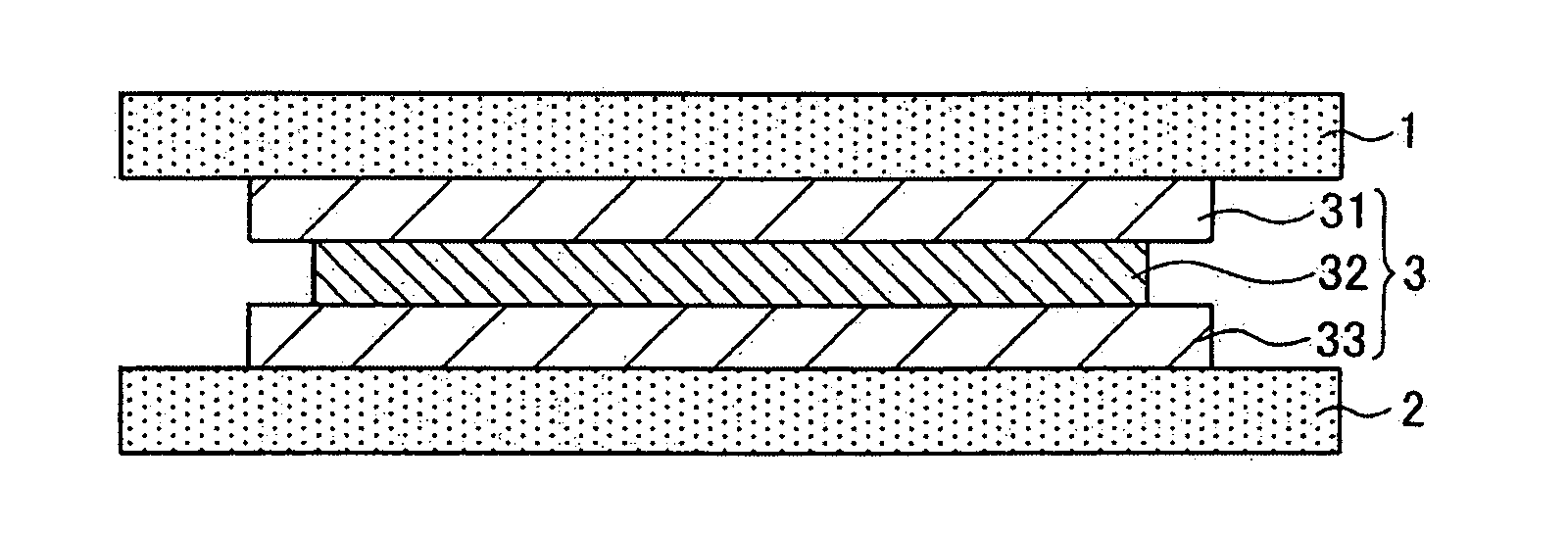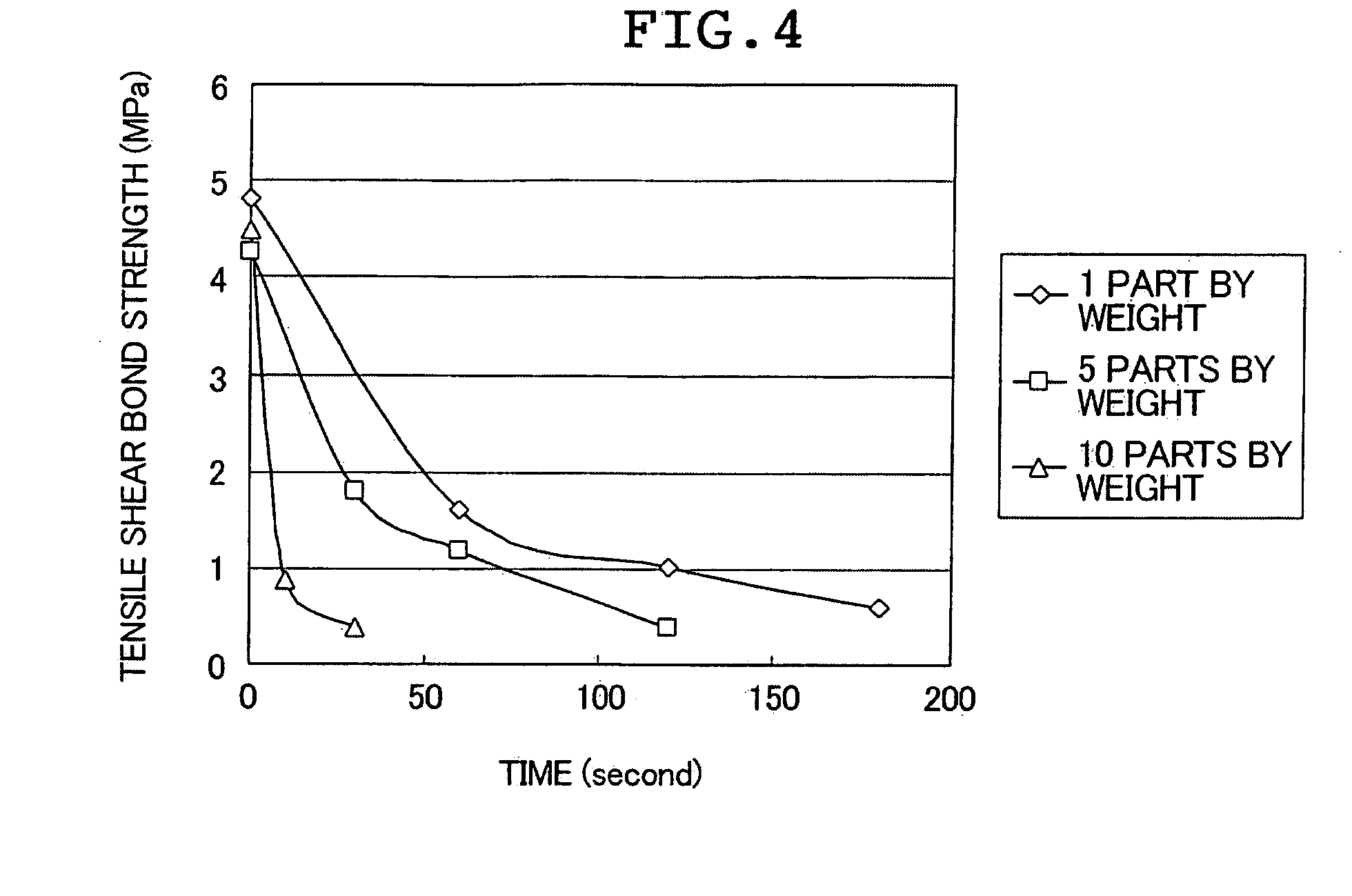Electropeeling composition, and making use of the same, adhesive and electropeeling multilayer adhesive
- Summary
- Abstract
- Description
- Claims
- Application Information
AI Technical Summary
Benefits of technology
Problems solved by technology
Method used
Image
Examples
examples
[0174]Next, the electropeeling composition of the invention is illustrated more fully by way of examples, which are not intended to limit the scope of the invention.
Urethane Prepolymer 1
[0175]300 g of polypropylene glycol (EXC2020; number-average molecular weight, 2,000; Asahi Glass Co., Ltd.), 700 g, of polypropylene triol (EXC5030; number-average molecular weight, 5,000; Asahi Glass Co., Ltd.) and 542 g of plasticizer (DINA; New Japan Chemical Co., Ltd.) were mixed together, then dehydrated under reduced pressure at 110° C. for 8 hours.
[0176]Next, diphenylmethane-4,4′-diisocyanate (Cosmonate PH; produced by Mitsui Takeda Chemicals, Inc.) was added to this mixture in an amount such as to set the index expressed as NCO groups / OH groups (number of isocyanate groups per hydroxyl group) to 1.7, and stirring was carried out in a stream of nitrogen at 80° C. for 24 hours, thereby synthesizing Urethane Prepolymer 1 (NCO %=1.23%).
Epoxy Resin 1
examples 1 to 5
Comparative Examples 1 and 2
[0178]The respective ingredients shown in Table 1 below were formulated in the proportions (parts by weight) shown in Table 1 per 100 parts by weight of Urethane Prepolymer 1 or Epoxy Resin 1, then uniformly dispersed in a high-viscosity mixer, thereby giving a resin composition.
[0179]Each of the resin compositions obtained was evaluated as described below to determine the adhesiveness and the detachability following the application of an electrical current. The results are shown in Table 1 below.
Adhesiveness
[0180]The respective resin compositions thus obtained were used to bond together two steel sheets (each 100×25×1.6 mm). Specifically, as shown in FIG. 2 (showing a test specimen furnished for the adhesion test), the resin composition was applied to a portion (20×25 mm) of the steel sheets in such a way as to result in an adhesive layer thickness of 1 mm, and the sheets were bonded together.
[0181]Following adhesion, the composition was allowed to cure ...
examples 6 to 18
Comparative Examples 3 to 6
[0209]The adherends were bonded together with multilayer adhesives obtained using the respective compositions prepared above.
[0210]Specifically, in order to form the multilayer adhesive shown in FIG. 1, the first adhesive layer 31 and the third adhesive layer 33 shown in Table 3 below were each formed to an adhesive layer thickness of 2 mm on, respectively, a first adherend 1 and a second adherend 2, then cured at room temperature for 5 days. Next, the second adhesive layer 32 shown in Table 3 below was pressed therebetween to a thickness of 2 mm, and cured at room temperature for 5 days. The reference numbers mentioned here together with the various components denote the symbols shown in FIG. 1.
[0211]As shown in Table 3 below, an electrodeposition-coated sheet or a glass sheet was used as the first adherend 1, and an electrodeposition-coated sheet or a steel sheet was used as the second adherend 2.
[0212]The adhesiveness and the detachability following the...
PUM
| Property | Measurement | Unit |
|---|---|---|
| Percent by mass | aaaaa | aaaaa |
| Percent by mass | aaaaa | aaaaa |
| Percent by mass | aaaaa | aaaaa |
Abstract
Description
Claims
Application Information
 Login to View More
Login to View More - R&D
- Intellectual Property
- Life Sciences
- Materials
- Tech Scout
- Unparalleled Data Quality
- Higher Quality Content
- 60% Fewer Hallucinations
Browse by: Latest US Patents, China's latest patents, Technical Efficacy Thesaurus, Application Domain, Technology Topic, Popular Technical Reports.
© 2025 PatSnap. All rights reserved.Legal|Privacy policy|Modern Slavery Act Transparency Statement|Sitemap|About US| Contact US: help@patsnap.com



